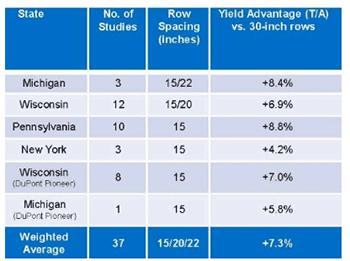
Consider changing seeding rate and row width

As growers consider planting options for corn silage acreage, increasing the seeding rate and narrowing the row widths can boost yields.
University trials and research by DuPont Pioneer show that silage yields can rise when growers use greater plant populations and narrow planting row spacing.
Greater seeding rates typically offer expanded yield potential. Optimum plant population varies by soil type, soil fertility, water availability and plant genetics. However, more advanced corn genetics are typically better suited to handle the increased stress of higher plant populations.
University and private research confirms that rows less than 30 inches apart are likely to increase corn silage yield. Thirty-seven experiments in four states revealed tonnage increases averaging 7% for row spacing of 15, 20 or 22 inches, compared to traditional 30-inch rows.

advantage of narrow rows versus 30-inch row spacing.
Increasing the seeding rate normally doesn't require investing in additional equipment, but switching to narrow rows usually requires equipment purchases or hiring custom operators for planting and harvesting.
As growers plan for higher yields, they also need to adjust for increased demands for soil fertility and water. In addition, narrow rows can limit post-emergence weed control and fertilizer applications. Growers are often committed to harvesting narrow row corn for silage due to available equipment.
Increasing population and decreasing row spacing will likely increase plant heights. This may result in a larger risk of lodging and green snap, and slightly slower plant maturation with a corresponding lower percentage of dry matter at harvest. It can also culminate in a modest reduction in percentages of starch content and fiber digestibility.
Understanding these issues helps growers weigh the potential benefits and risks of increasing the seeding rate and narrowing row widths. These two decisions should be made independently, weighing the potential benefits and risks. If a grower has decided to transition to this approach, experts recommend growers maximize plant populations before investing in narrow row-planting and harvesting equipment.
For more information on seeding rates and row widths, visit www.pioneer.com or contact your local Pioneer sales professional.
1.6.2014